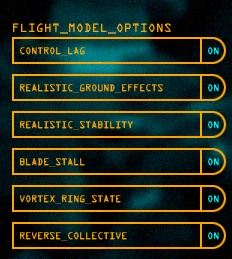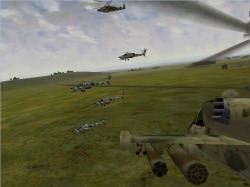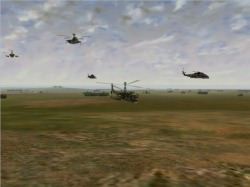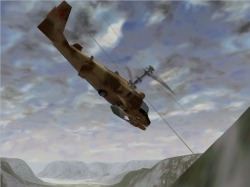|
Flying the Ka52 Alligator by Zero G |
||||
|
In the new sim from SIMIS, KA-52: Team Alligator there are some added twists to the FM (flight model) that you will need to know in order to be successful in the air. After many hours of experience, here is a little overview that will help you out.
 The first thing that contributes to a unique flight model is that the KA-52 is a helicopter with two counter-rotating main rotors (a lot like marriage!) This saves you from having to deal with torque while in the air. Each rotor cancels the other's torque, leaving the KA-52 with no need for a tail rotor and with an ingenious system to give you with the ability to hover and turn on the spot. The pedals still work the same as they would on any normal helo with a tail rotor. Instead of controlling a tail rotor, the pedals adjust the amount of torque to the main rotors individually. The affect gives you the same control as a tail rotor would. There is a drawback to this system, though. At high speeds the main rotors can strike one another causing a total failure of flight controls. When flying at speeds in excess of 300 km/h be careful not to do any hard maneuvers; it can ruin your day. FM Options The FM options to turn on and off in the sim are as follows: Control Lag, Realistic Ground Effect, Realistic Stability, Blade Stalls and Vortex Ring State. I will give a quick explanation on what each does and what you will need to know to control or avoid it.
 Control Lag: This is a feature that is very easy to get used to. In fact if you leave it on from the start you will never notice what it does. In a helo the control inputs that are done by the pilot do not take effect until the rotor has moved about 90 degrees in its rotation. This translates into a very short delay in your control inputs being done by the helo. It is so short you will probably not even remember you have it on. Realistic Ground Effect: Ground effect (GE) gives you the ability to hover near the ground or water using less power then it takes if you are high above it. What happens when you are high above the ground is that the downwash from your rotors is free to disperse below you. If you are in a low hover the downwash is trapped below you and effectively increases the amount of lift the rotors generate. |
 With this option on you will notice when taking off that the helo will lose speed as you climb in a hover, and you will have to add more power to keep climbing once you climb out of your GE (about 15 meters.) You will also need to use considerably more power to stop and hover while high in the air. Having this option off will leave your helo with the power to climb and hover as if you were in GE at all times. Realistic Stability: This turns on and off the tendency of your helo to fall back to center when the joystick is released. Having it off makes holding a set speed quite easy, but I find turning at low altitude is made more dangerous since you must force the helo out of its turn. Use of this will depend on the player. I find having the stability off is harder, partly because of what I am used to in the real world. Some may find that they like the helo holding its speed so much that they will deal with the turning. Blade Stalls: Blade stalls are very dangerous in the KA-52 because of the counter rotating blades. The helo will not do any of the normal RBS (retreating blade stall) effects that a single rotor helo will do other than the very bad shake leading up to the problem. As stated before the main rotors can strike if you attempt to do any quick maneuvers while at a very high speed.
 I would tell you to watch out if you are at 300 km/h or more, though it will take a very quick move to cause problems at that speed. As you approach 350km/h the danger increases greatly. It is very possible for the rotors to strike as you get close to 350km/h even if your maneuvers are smooth. Be sure you need that much speed before you risk using it. Turning off blade stalls will stop any rotor strikes from happening. Vortex Ring State (VRS): This is the feature that will kill many virtual pilots as they try to master it. Vortex Ring State is entered when you are flying at a slow air speed with a fast rate of decent; the rotors are caught in the downwash that they create. This causes a total loss of lift and is made worse by adding more collective pitch as you fall. Go to Part II
|
|||
|
Copyright © 1997 - 2000 COMBATSIM.COM, INC. All Rights Reserved. Last Updated December 3rd, 1999 |
||||
